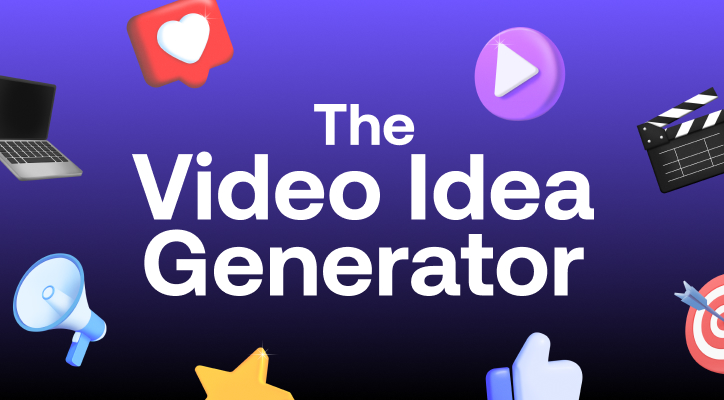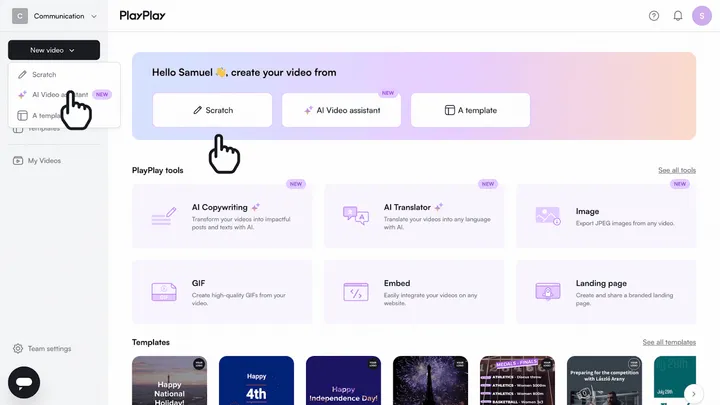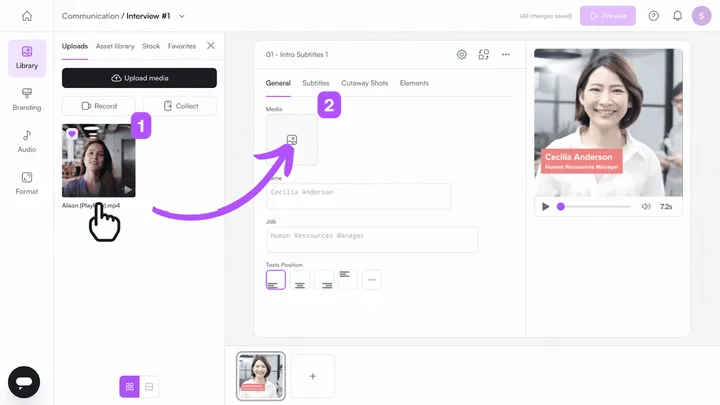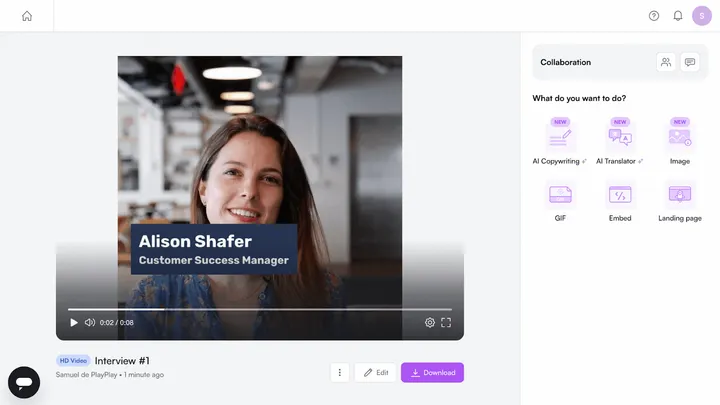If you thought that being a skilled copywriter and social media guru is enough to make you a marketing rockstar — you may want to think again.
Video is now the most in-demand skill for a marketer. They’re more informative, engaging, and effective than any other type of content.
In this article, we’ll discuss 14 types of video content you should use for your marketing strategy, and why they are effective tools for audience engagement.
14 types of video content for achieving your marketing goals
The sky’s the limit when it comes to marketing videos. It’s important to keep in mind that which videos you choose to create will depend on your unique goals, needs, and marketing strategies.
Here are the top 14 types of video content that every marketer should create and why.
1. Explainer videos to help users understand your niche
Explainer videos do just what you’d think — they introduce a problem or challenge, then explain exactly how it can be solved!
If your product or service is the solution, these videos are a fast, effective way to demonstrate its value. But explainer videos don’t need to be exclusively product-related. Try explaining a relevant issue or topic your audience cares about — you’ll still be establishing your expertise, credibility, and authority.
To make your explainer videos stand out, take a thought-leadership approach by inviting a subject expert to take part. Ideally, this would be somebody at your company, or a known industry influencer. You can also try using animation and incorporating dynamic transitions, especially if your topic is dry or complex.
Industry: Payment Software
Video length: 1 minute 9 seconds
Why it works:
- Honey explains the potential pitfalls with shopping online, and then they show how you can help solve this problem with their product. The video is perfect for convincing prospects they should use Honey.
- It’s clear, concise, and relatable!
2. How-to videos and tutorials to make learning easy
The goal of a tutorial video is to teach viewers how to do something. For brands, it’s usually about helping users to get the most out of your product. A great option for peaking a potential customer’s interest, and also for customer retention. By providing useful tutorials, you’re showing customers that even after they click ‘buy,’ you’re still there to help.
‘How-to’ type queries are also some of the most searched-for terms out there. Make sure you’re getting a slice of that traffic by making videos that answer your customers’ most-queried pain points. To do this, we recommend you take time for keyword research!
As with explainer videos, 'how-to's can either be product-related or address other relevant topics your audience cares about.
Industry: Video Game
Video length: 4 minutes 32 seconds
Why it works:
- Playstation VR makes this product tutorial feel slick, engaging, and even futuristic with minimalist animation and a good soundtrack.
- The video hints at the experience users will enjoy when playing their favorite VR games, which gives a positive image of the company.
3. Demo videos to show your product in action
Demo videos are your chance to get hands-on and show off your product in action.
For digital or software products, demos often include screen recordings, a voiceover, and some fun animation to make everything crystal clear. For physical items, try filming an ‘unboxing’ product video that captures all the excitement of a brand-new purchase.
Product demo videos are an excellent tool to leverage in the middle of your marketing funnel. By helping your prospects get to know your product more intimately they can make an informed buying decision.
Industry: Beauty and Cosmetics
Video length: 5 minutes
Why it works:
- The Lip Bar channels a video type that’s highly popular with their audience: makeup tutorials. This ensures they’ll stay relevant with their audience while meeting their interests and preferences.
- The company demonstrates the quality of their concealer in a vlog-style video which is a format their viewers already know and trust.
4. Client testimonial or case study videos to back up your brand promise
Social proof is powerful — that’s why 93% of buyers check reviews before buying an item online.
Imagine you’re browsing in a store, and another shopper approaches you and starts raving about the product in your hand. No doubt you’d find that convincing — and you can create the same effect with video testimonials. That’s why they’re so powerful on your brand’s website, particularly on sales or product pages.
Instead of just telling people how great your product is, show them by putting your customers front and center in a testimonial video!
Industry: Environmental and Marine Conservation
Video length: 3 minutes 13 seconds
Why it works:
- This testimonial from PlayPlay’s client, Sea Shepherd, features their Director of Communications speaking directly and openly about her experience with the service. It’s unfiltered, authentic, and honest!
- The testimonial has a casual, video-chat feel that makes the video slick and effective, ensuring powerful social proof.
5. Brand awareness videos to help spread the word
Brand awareness videos are basically the traditional web or television advertisement — brief, creative, and memorable videos intended to boost brand recognition.
These videos live at the top of your marketing funnel sharing what makes your brand special — your style, your product, your mission, and ultimately, the value you offer your customers.
Industry: Technology
Video length: 2 minutes 55 seconds
Why it works:
- Apple pushes the limits of creativity while reinforcing their “think different” slogan, which helps them emphasize their brand identity and qualities.
- The company also has an ambitious and slick production, which makes the video professional, credible, and engaging.
6. Content promotion videos to maximize exposure
Did you know video can help you get the most out of other types of content? Today, video creation is so quick and easy that brands are using it to promote their blog posts, ebooks, and podcasts on social media.
A short, snappy video teaser is the best way to grab your audience’s attention on social media and lead them to more ‘traditional’ pieces of content. Let’s face it, it’s harder than ever to get people to read a 10-page report! But a promo video can peak viewers' interest and encourage them to dive into the details.
Try creating short videos to recap content you’ve already produced, such as turning a blog post into a series of TikToks. Or, you can create a promo video to highlight key learnings from a recent eBook enticing viewers to download the content.
Industry: Intergovernmental
Video length: 18 seconds
Why it works:
- The OECD uses a short video on social media to promote their podcast, which is the most popular type of video audiences consume.
- This teaser is bound to attract more listeners to the podcast because of its soundbite audio extract, eye-catching visuals, and a CTA leading to the full episode.
7. Company culture videos to strengthen your employer brand
Behind every brilliant product and slick brand, there’s a bunch of talented people making it all happen. Company culture videos put your people center stage, helping to express your brand’s personality and what makes it unique.
Company culture videos are important for attracting new talent, but they also let you show off your values to new and existing customers. Promoting the human side of your brand is crucial; in today’s market, customers are more likely to engage with brands they feel personally aligned with.
HubSpot's video presents some of the team and their workspaces, featuring a voice-over narration about their positive experience.
Industry: Software and Technology Industry
Video length: 3 minutes 30 seconds
Why it works:
- The video shows off the team’s diversity, collaboration, and dedication to promoting great company culture. This emphasizes HubSpot’s priorities when it comes to their workplace environment!
- The video also shows viewers how much pride the company has in its employees, highlighting them as their greatest asset. This helps build a positive image of the company and encourages prospects to apply.
8. Event teasers and recaps to get more attendees
Video is an indispensable tool to get the most out of your events. Whether it’s an in-person or virtual event, plenty of hard work and planning is needed. And video can help you get the best possible return on all that effort!
Try creating teaser videos to promote your event before the big day while building hype and encouraging attendees to sign up. Be sure to highlight key information like keynote speakers, the agenda, and key takeaways of the event.
Don’t forget to include a clear call-to-action that leads to the registration page so your viewers can sign up immediately.
Industry: Video Creation Software
Video length: 54 seconds
Why it works:
- PlayPlay’s Content Summit video is incredibly effective because of its key messaging and branding, animations, background music, and ending with a clear CTA.
- It’s an engaging marketing asset because it clearly highlights the exciting speakers and brands which makes viewers want to tune in.
9. Interviews and Q&As to build thought leadership and trust
Building relationships with potential customers is crucial to gaining their trust. By investing in your thought leadership efforts, your target audience will see your company as the industry authority and engage with your messages.
Interviewing your senior employees or industry experts on camera to discuss a relevant topic is one of the best ways to build trust. In fact, 93% of consumers believe that CEO engagement on social media helps communicate corporate values and shape the company’s reputation.
Filming an interview or a Q&A video will provide audiences with value-packed content on relevant topics — all in an engaging, personal format that will earn their trust. Give your brand a human face and the results will follow!
Industry: Revenue Operations
Video length: 3 minutes 45 seconds
Why it works:
- This video by Clari’s CEO is an excellent example of thought leadership content, posted as a series of episodes covering various niche topics.
- The episode is simple but highly effective because it features an expert and his knowledge of the specific topic.
10. Webinar recordings to share in-depth knowledge
If you’ve hosted a webinar packed with tips and advice, why not record and host it on your website or Youtube page? Long-form video content is perfect for deep diving into a particular subject, giving your audience the knowledge they need to succeed.
Webinar recordings can easily be broken down and repurposed into short videos for social media. Grab your audience’s attention with a highlights video explaining the key takeaways or tips from the talk, and drive them to your website or Youtube channel to watch the full version.
Industry: Video Creation Software
Video length: 40 minutes
Why it works:
- This talk hosted by PlayPlay features a leading marketer who gives advice to all companies, and how they can apply it within their organization.
- It’s also a great example of how you can use webinar content for all your company communication channels.
11. User-generated videos to engage your community
User-generated videos are often created by customers to highlight and promote your products, features, or services.
From ‘unboxings’ to ‘How To’s, UG content is a valuable form of social proof that brings authenticity to your pitch. In fact, 93% of marketers agree that consumers trust user-generated content more than content created by brands themselves. And the bonus? Your customers put in the hard work for you!
Your user base is a goldmine of knowledge, so dig into forums and social media to see what they’re creating or sharing in relation to your product. Try partnering up with influencers and fans to promote their videos, or extract clips to produce your own video, thanking them for their efforts — this is a great way to engage your community!
Industry: Collaboration Software
Video length: 5 minutes 45 seconds
Why it works:
- Created by a Notion user, this video is a great example of how user-generated content (UGC) can be leveraged to authentically promote any brand.
- This video guides the audience through how Notion can be used by content creators to turn their work into a seamless production. It’s filled with tips, screencasts, and step-by-step instructions.
12. Quarterly recap videos to celebrate wins and promote new projects
A lot can happen in a quarter and your community wants to know what you’ve been up to. Quarterly recap videos give a rundown of your company’s recent activity in bite-sized, engaging format that’s perfect for social media.
Want to highlight recent events, promote new product features, or reveal exciting projects in the pipeline? A quarterly recap video is the best way to celebrate your company’s achievements and offer fresh updates to your community.
Recognize your team’s hard work, boost your employer brand, and get pumped for the quarter ahead!
This video created by PlayPlay (using PlayPlay, of course) shows how easy it is to recap recent achievements in a short and snappy video.
Industry: Video Creation Software
Video length: 1 minute 17 seconds
Why it works:
- The video summarizes what the marketing, product, and sales teams at PlayPlay have been working on, giving the teams the recognition they deserve. It also features a sneak-peek at the company’s offsite celebrations which shows how fun the work environment can be.
- It features a variety of content types: photos and short clips, which keeps the viewer engaged at every second.
13. Livestream videos to gain social media followers
Going live is a powerful way to form a personal connection with your audience. Live videos are the most authentic form of brand content, and customers are more likely to engage with brands they feel personally connected to.
These fresh ‘unfiltered’ videos create a feeling of urgency for your viewers. They know they’re among the first to hear your message which creates extra excitement. With chatbox options and emoji reactions, livestreams offer audiences a whole new way to interact with brands — in the here and now.
Whether you’re broadcasting from a tradeshow event or hosting a masterclass, live streams can help you strengthen your brand’s social media presence and gain new followers. Disclaimer: make sure you’ve thoroughly prepared before going live… once it’s out there, there’s no going back!
Industry: Internet Content and Information
Video length: 17 minutes 47 seconds
Why it works:
- This livestream video by Buzzfeed is all about having fun, which makes it entertaining for any viewer!
- It drives engagement through its dance competition format, where viewers are able to vote for their favorite dancers in real-time and encouraged to interact daily with Buzzfeed.
14. ‘Thank You’ videos to show appreciation for partners and customers
Everyone loves to feel appreciated, and your customers are no different.
Whether you’re creating a personalized video to email to each customer or a general version for social media, ‘Thank You’ videos show your community how much you value their support and loyalty.
Record a quick, personal message from your CEO or employees — it’s a sure way to humanize your brand and boost customer retention.
Industry: Collaboration Software
Video length: 1 minute 21 seconds
Why it works:
- Slack’s ‘Thank You’ video is a slick recap of the company’s journey from its creation in 2014 up to the present day, which gives viewers a great look into the company’s history and strong evolution.
- It features an animated timeline of company milestones, thanks its users, and promotes its service all at the same time!
4 questions to ask when creating a brand video
Before getting started with video, you’ll need to know exactly what you’re working towards.
That way, you can make sure you’re using resources effectively and getting the best ROI possible. Video can easily complement your existing content marketing efforts such as your email lists, blog posts, ebooks, whitepapers, and social media channels.
But, you need to consider which of these channels are more important to you and why. Start by asking yourself these 4 simple questions.
1. Define your brand goals
Start by clarifying what you want your brand to accomplish. Is your company more concerned with brand awareness, search engine optimization, boosting conversions, or nurturing existing customers?
These goals will help steer your content strategy, refine your messaging, and track your results. Make sure they align with your overall business objectives to keep everything working toward the same vision.
The list of video content types above shows how each video applies to different goals and points in your sales funnel.
2. Determine how much time and resources you can devote to your video content
Video is accessible to all marketers these days, thanks to easy, user-friendly video creation tools like PlayPlay. But, the resources or tools you’re working with will still determine your approach and play a massive role in the success of your marketing strategy.
If you’re working alone, for example, you might make quick animated video graphics for social media. If you have a larger team however, you may focus on creating more elaborate videos like interviews and company culture content.
3. Identify your customers’ needs and how your video can meet them
Understanding your customers’ needs, preferences, and pain points will help you create useful video content that nurtures customer relationships. Do your users need help understanding the intricacies of your product? Or are they looking to be entertained and connect with others?
No matter the specifics, there’s a type of video content that will help you get there. You can try behind-the-scenes videos, brand videos, promotional videos and more, depending on whether you are focused on building awareness, pushing conversions, or increasing retention.
4. Choose the right platforms to distribute your video content
Which platforms and types of video content does your audience already prefer?
If your target audience is online, they’re already engaging with video. Your task is to find out where, when, and what types of video content they consume. Then, you can create videos tailored to those preferences.
To understand what kind of video your audience likes, try analyzing how they engaged with your previous posts. For example, did you make a Reel that got thousands of views, but didn’t get much success when you posted it on YouTube?
The answer to those types of questions about your video’s previous performance will help you determine your strategy. And if you’ve never created a video before, you can host a poll for your audience via email or social media, or take inspiration from your competitors.
How to create stunning video content with PlayPlay
As a PlayPlay user, you can create videos from scratch, speed things up using templates, or skip the scrappy process altogether with AI-generated videos.
Here, we’ll show you how to create a professional video from scratch using PlayPlay’s video software.
Step 1: Sign up for a PlayPlay account. Our software is free for seven days.
Step 2: In your dashboard, select the option to create a video from scratch.
Step 3: Add a screen to start creating your video. You can choose any of the pre-made screens to get started.
Step 4: Add video elements to your screen, such as subtitles and text.
Step 5: Check your video screens to make sure everything is correctly in place.
Step 6: Click on the Generate HD video button to get a high-definition version of your video.
Step 7: Once the HD generation is done, you can download your video and share it with colleagues or upload it to your communication channels.
Create stunning marketing video content with PlayPlay
Now that you’ve got a solid understanding of the most important types of video for marketers to master, it’s time to walk the walk! Take inspiration from the above examples of different video types and start making your own. You’ll be surprised how good you’ll get with each one you create.
But every video marketer needs the right tools. Want a quick and easy way to make video content? Try PlayPlay — the online video creation tool that enables anyone in your team to turn any message into a compelling video. Start today with our 7-day free trial!
Get ready to revolutionize your marketing strategy with video’s entertainment, educational, and community-building powers.
Video is still king! Video content is by far the biggest trend on social media, so you should make it a priority for your social media marketing strategy. People tend to watch TikToks, Instagram Reels, and YouTube Shorts and video content on LinkedIn. Be sure to post videos on these platforms to increase your audience engagement.
Subtitles and on-screen text improve video performance by making content easier to follow and more engaging, especially for sound-off viewers. Plus, with 32% of people still drawn to text posts, it’s a smart way to broaden your reach and resonate with different viewer preferences.
Although video is the most popular content type, there are many other content options for your marketing strategy! These include: videos, blog posts, ebooks, infographics, and podcasts.
The 4 top-performing content themes on social media are: educational, inspirational, entertaining, and conversion-driven posts. These themes resonate with audiences by providing value and driving action. By incorporating one or all four on your social media, you can create a well-rounded content strategy that boosts engagement and helps you achieve your business goals.








